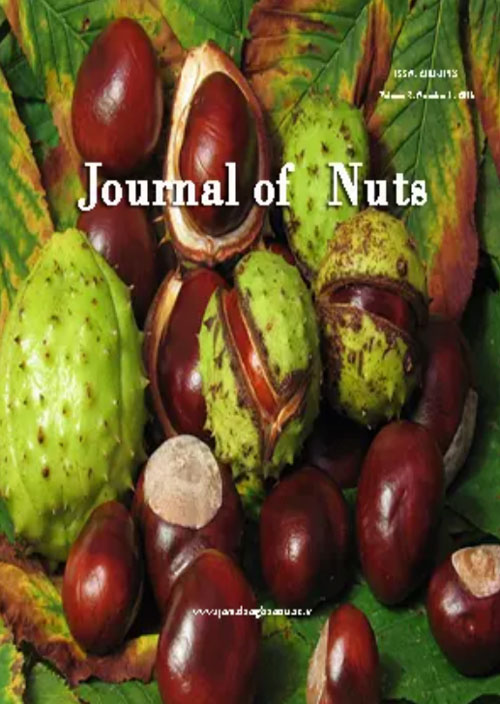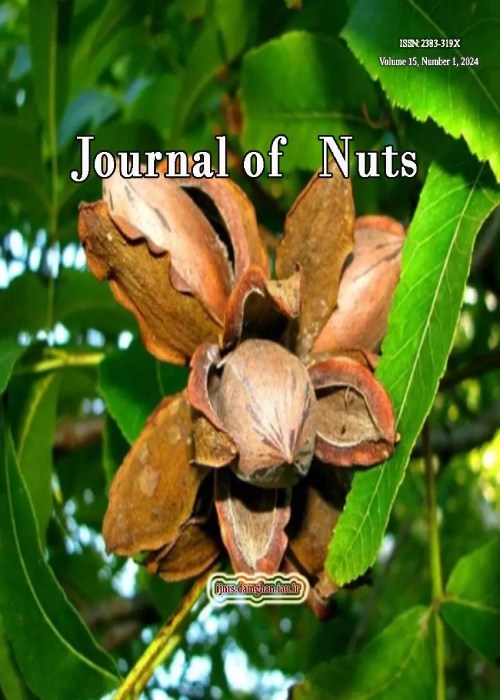فهرست مطالب

Journal of Nuts
Volume:13 Issue: 4, Autumn 2022
- تاریخ انتشار: 1401/08/22
- تعداد عناوین: 6
-
-
Pages 247-257Hazelnut (Corylus avellana L.) production is well-established in Iran. Cultivars that are resistant to plant diseases are needed to expand hazelnut cultivation. The present research aimed to study and compare the susceptibility of 48 Iranian, local and exotic hazelnut cultivars (C. avellana L.) to Phyllactinia guttata, the pathogen causing powdery mildew (PM). The study was conducted under naturally occurring infection at a Research station for hazelnut in the Guilan province (Astara-north of Iran), during the period 2019-2020. Experiments were arranged in a randomized complete block design with four replicates. The studied cultivars were divided in classes of susceptibility to Ph. guttata depending on the leaf infection (%) and disease severity index (DSI), using a 8-rating scale (0= no visible leaf symptoms to 7 = more than 85% of the leaf surface with symptoms). None of the investigated cultivars demonstrated resistance. Although no plot was scored less than 4, highly significant differences (P=0.01) in susceptibility among hazelnut cultivars were found. So that, 75% of the hazelnut cultivars exhibited high susceptibility to PM. No correspondence was observed within cultivars based on geographical origin. In general, Iranian superior local cultivars Gercheh, Pashmineh 89, Shast-e-Ras, Gerdoii 89 and four Spanish commercial cultivars Fertile de Coutard, Segorbe, Negret, and 'Ronde du Piedmont showed high susceptibility reaction to PM. It was recommended that while paying attention to the susceptibility of cultivars to PM, control measures should also be considered.Keywords: Corylus avellana, Hazelnut, Phyllactinia guttata, Powdery mildew, Susceptible cultivars
-
Pages 259-271The purpose of this study is to develop a model for knowledge management of Iranian pistachios based on the Knowledge Management for Development (KM4D) model. The knowledge of farmers and new scientific knowledge are complementary in terms of strengths and weaknesses. By combining the two, one can achieve the success that would not be achievable by using them on an individual basis of two. The present study is an exploratory mixed study. A study was designed based on the combination of library studies, documentation, and exploratory mixed studies to form a cross-sectional study in terms of data analysis and processing method, and correlational research. The statistical population of the research is divided into two parts: the qualitative section which includes 7 people and the quantitative part which includes 149 farmers, experts, specialists and experts in pistachio agriculture, and horticulture. Simple random selections are selected. To analyze the data in the qualitative part, the grounded theory method based on the KM4D model has been used. The quantitative part based on descriptive statistical analysis using SPSS software version 23 to generate relevant graphs, mean, median, and frequency table. Implementing knowledge management in agricultural organizations has a significant role in improving pistachio agriculture and horticulture development. It will result in reducing costs, increasing quality, innovation, and continuous improvement. The current study has presented a new model in knowledge management of Iranian pistachios agriculture, which will benefit from the quantitative and qualitative development of this agricultural product. The main application of this study is to increase added value of farmer's products.Keywords: Knowledge management, Agricultural Development, horticulture, Pistachio production
-
Pages 273-288Hazelnut (Corylus avellana L.) is mainly cultivated in the north and northwest of Iran. In this study, the genetic structure and diversity of 52 hazelnut accessions were investigated using 9 simple sequence repeats (SSR) loci. The number of alleles per locus ranged from 2 to 3, with a total number of 19 alleles. The highest and lowest values of observed alleles were found in the Fandogloo-Ardabil (Na=2.22) and 6th population (Na=1.77), respectively. The highest and lowest effective alleles were observed in Fandogloo-Gilan (Ne=1.94) and Hatammeshasi (Ne=1.56) populations, respectively. The highest value of the Shanon index (I=50%) was found in Hatammeshasi. A high level of genetic diversity, including expected heterozygosity (He), was found in Hatammeshasi population (He=0.50), while the highest value of observed heterozygosity (Ho) was found in Talesh population (Ho =0.25). The polymorphic information content (PIC) varied from 0.87 to 0.98 per locus. The mean values of PIC, Fis, and Fst for all loci were 0.88, 0.53, and 0.15, respectively. Overall, gene flow between populations (Nm=1.57) was observed in the studied populations. The highest correlations (r=0.94, p<0.05) were observed between the Eshkavar and Fandogloo-Gilan, and Hatammeshasi and Fandogloo-Ardabil populations. Regarding the X2 test at p<0.05, the studied populations did not follow the Hardy-Weinberg equilibrium. Cluster analysis based on UPGMA method divided hazelnut genotypes into four groups. The results confirm that SSR is a reliable DNA marker that can be used to accurately study genetic diversity in hazelnut populations.Keywords: DNA fingerprinting, Filbert, Gene flow, germplasm
-
Pages 289-300
Biochar-based fertilizers, customized to specific soil conditions, have piqued public attention to enhance soil quality and carbon sequestration. The incorporation of biochar into agricultural fields can become a primary factor in the preservation of soil productivity and fertility. However, there is still no conclusive experimental evidence to support this claim. In this study, a split-plot experiment was carried out according to a randomized complete block design (RCBD) using three replications to evaluate the influence of irrigation and varied amounts of biochar-based fertilizer on peanut plants' yield to determine the water use efficiency (WUE). The primary treatment with different irrigation cycles and no irrigation, and the sub-treatment with biochar-based fertilizer of 50, 100, and 150 kg N ha-1 and no fertilizer, were performed in Sulaymaniyah which is located in the east of the Kurdistan Region of Iraq. The results revealed that the seven-day irrigation cycle produces the largest pods and seeds, with 4325 and 2435 kg ha-1 yields, respectively. The 100 kg ha-1 biochar-based fertilizer yielded the highest output, with a pod yield of 3652 kg ha-1 and a seed yield of 1921 kg ha-1. According to the results of the interaction between irrigation management and biochar-based fertilizer, the irrigation treatment had a maximum seed yield of seven-day and the fertilizer treatment had a maximum seed output of 100 kg N ha-1 with an average of 3462 kg ha-1. The variance analysis results indicate that water use efficiency in irrigation management, different levels of biochar-based fertilizer, and their combined effect on total biomass, seed, and pods were significant.
Keywords: Fertilizer management, harvest index, Irrigation Management, Peanut, water use efficiency -
Pages 301-311Pistachios (one of 50 healthy foods) are essential for human health. The ripening stage is of great importance for food processing, as the chemical composition of this fruit is heavily influenced by its maturity level. For instance, as premature pistachio has unique green color, it can be used in desserts, sauces, ice creams, and chocolates, while mature pistachios often used as snacks. Considering that the nutrients in the pistachio kernel are dependent on various factors, especially environmental conditions, determining the amount of these compounds during the ripening stages of the pistachio kernel can considerably contribute to the appropriate harvest time and increase the duration of its storage period. Biochemical compounds such as carbohydrates, fats, and proteins are less affected by growth but may affect pistachio kernel taste and its nutritional value and health. The highest amounts of carbohydrates, fats, and proteins are available at the time of optimal harvesting when the hull is fully ripe. Phenolic compounds and antioxidant activity of pistachio decrease during ripening, and oil and fatty acid levels increase with the ripening period. In the case of the color parameter, the L factor decreases during the ripening period, and the a and b factors increase. Different stages of ripening have a significant effect on pistachio compounds. Nutrients in pistachio kernel are dependent on various factors that their diagnosis in different stages of growth contributes considerably to harvesting at the right time and increasing the storage period of this product.Keywords: maturation, Nutritional value, Pistachios, Quality
-
Pages 313-322
In this work, the concentrations of flavonoid and anthocyanin pigments determined from different pistachio (Pistacia vera) cultivars collected from Damghan and Rafsanjan, were investigated. The flavonoid compound was evaluated as aluminum chloride complex and stated as mg of rutin equivalents/100g of the sample weight. To estimate anthocyanin content, colorimetric assays were used. The highest concentrations of flavonoid compounds (25mgRu100g-1fw) were found in the Abbas Ali cultivar from Damghan, followed by Kalehghoochi and Fakhri. The lowest level of anthocyanin was obtained in Khanjari from Damghan (7µmolg-1fu). The amount of anthocyanin and flavonoid pigments in different tissues of pistachio fruits showed that there was no significant difference in pistachio hull and kernel. After harvest, different cultivars indicated various values for phytochemical properties and flavonoid compound of pistachio hull and kernel ranged from 12.31 to 30.3 mgRu100g-1fw and 19.22 to 27.92 mgRu100g-1fw, anthocyanin pigment of pistachio hull and kernel from 6.81 to 11.1 µmol g-1fu and 4 to 18 µmolg-1fu, respectively. The pistachio kernel contained high amounts of flavonoid content, especially in the Fakhri cultivar, and the pistachio hull contained low levels of anthocyanin value, especially in the Akbari cultivar. Among the investigated pistachio kernel cultivars, Abbas Ali indicated higher values of anthocyanin pigment than Kalehghoochi, Akbari, Khanjari, and Fakhri. Our findings could be beneficial for introducing interesting properties to the pistachio nut such as cultivar-rich resources from anthocyanin and flavonoid contents and can be used when selecting a special cultivar for a particular application and pharmaceutical industry.
Keywords: Chemical Properties, Colorant, Colorimetric assay, Pistachio kernel, Polyphenols


